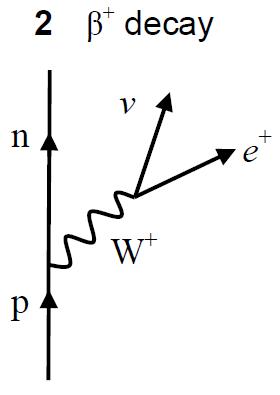

In 1931 Enrico Fermi renamed Pauli’s “neutron” to neutrino as a word play on neutrone, the Italian name of the neutron. Neutrinos are usually formed from transforming a particle from one form to another in a process known as positron emission however, in beta decay. With my best regards to you, and also to Mr Back. Why are we interested in neutrinoless double beta decay The recent discovery of neutrino oscillations clearly indicates that neutrinos do have mass. The positron and neutrino fly away from the nucleus. Unfortunately, I cannot appear in Tubingen personally since I am indispensable here in Zurich because of a ball on the night of 6/7 December. During beta-plus decay, a proton in an atoms nucleus turns into a neutron, a positron and a neutrino. Thus, dear radioactive people, look and judge. From now on, every solution to the issue must be discussed. But only the one who dare can win and the difficult situation, due to the continuous structure of the beta spectrum, is lighted by a remark of my honoured predecessor, Mr Debye, who told me recently in Bruxelles: “Oh, It’s well better not to think to this at all, like new taxes”. I agree that my remedy could seem incredible because one should have seen those neutrons very earlier if they really exist. The mass of the neutrons should be of the same order of magnitude as the electron mass and in any event not larger than 0.01 proton masses > The continuous beta spectrum would then become understandable by the assumption that in beta decay a neutron is emitted in addition to the electron such that the sum of the energies of the neutron and the electron is constant… Namely, the possibility that there could exist in the nuclei electrically neutral particles, that I wish to call neutrons, which have spin ½ and obey the exclusion principle and which further differ from light quanta in that they do not travel with the velocity of light. He suggested that this “neutron” was also emitted during beta decay and had simply not yet been observed:Īs the bearer of these lines, to whom I graciously ask you to listen, will explain to you in more detail, how because of the “wrong” statistics of the N and Li6 nuclei and the continuous beta spectrum, I have hit upon a deseperate remedy to save the “exchange theorem” of statistics and the law of conservation of energy. Inverse beta decay, commonly abbreviated to IBD, is a nuclear reaction involving an electron antineutrino scattering off a proton, creating a positron and a neutron.This process is commonly used in the detection of electron antineutrinos in neutrino detectors, such as the first detection of antineutrinos in the CowanReines neutrino experiment, or in neutrino experiments such as KamLAND and. The theory could be described as a point-like four fermion vertex similar to the one shown in gure 1, and inclusive of. His approach was a design similar to the radiation theory of light, where light quanta are emitted from an excited atom. They showed that a nucleus undergoing beta decay emits a neutrino with the electron, a discovery that was recognized with the 1995 Nobel Prize for Physics. In a famous letter written in 1930 Wolfgang Pauli suggested that in addition to electrons and protons atoms also contained an extremely light neutral particle which he called the neutron. 1 Fermi Theory of Beta Decay The rst theory of neutron beta decay was developed by Enrico Fermi in 1933. Neutrinos were first detected in 1956 by Fred Reines of the University of California at Irvine and the late George Cowan. A second problem was that the spin of the Nitrogen-14 atom was 1, in contradiction to the Rutherford prediction of ½. The notes on beta spectra that accompany the table are excellent. Each of the three experiments in the DOE initiative is searching for neutrinoless double beta decay by studying the decays from one element to another element, but each is investigating a different isotope: CUPID utilizes molybdenum (Mo-100), nEXO uses xenon (Xe-136), and LEGEND-1000 uses germanium (Ge-76). Neutrinos are so difficult to detect that the first direct evidence of them was not obtained until 1953. Beta Decay 2 with the Tables for the Analysis of Beta Spectra produced by the National Bureau of Standards.

The neutrino was not even proposed in theory until more than 20 years after beta decay was known to involve electron emissions. This was in apparent contradiction to the law of conservation of energy, as it appeared that energy was lost in the beta decay process. The neutrino is a particle emitted in beta decay that was unanticipated and is of fundamental importance. In 1911 Lise Meitner and Otto Hahn performed an experiment that showed that the energies of electrons emitted by beta decay had a continuous rather than discrete spectrum.

\) always have two fewer protons and two fewer neutrons than the parent.Historically, the study of beta decay provided the first physical evidence of the neutrino.


 0 kommentar(er)
0 kommentar(er)
